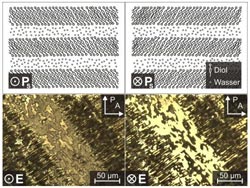Stuttgart researchers discover ferroelectric liquid crystal comprising mainly water

Molecular layers<br>University of Stuttgart IPC <br>
Although certain liquid crystals mainly comprise water, a spontaneous alignment of electrical dipoles could incur in them and consequently a spontaneous electrical polarisation could occur macroscopically: chemists from the Institute of Physical Chemistry at the University of Stuttgart (IPC) were able to show this and report about it in the leading trade journal “Applied Chemistry”*).
These so-called lyotropic liquid crystals are ordered solutions of organic molecules, for example in water. In the liquid crystal examined, chiral organic molecules with a specific inclination angle arrange themselves in layers. The solvent is between these layers. The surprising thing is: although the water layers between the molecular layers are comparatively thick (approx. 2 nanometres), the organic molecules have the same direction of inclination in each layer.
If an electrical field is created, it is possible to switch backwards and forwards between opposing directions of inclination through changing the field direction (see illustration). With this evidence of ferroelectricity in a liquid crystal solution was provided for the first time.
Materials showing evidence of a spontaneous electrical polarisation even without electrical field are described as ferroelectrics. Ferroelectricity was first discovered by Joseph Valasek at the beginning of the 20th century and was only known in solid crystals for a long time. Up to now it has been considered extremely improbable that ferroelectricity can also occur in lyotropic liquid crystals since these largely comprise small, disorganised solvent molecules.
This question already aroused the scientific ambition of the research group of Prof. Dr. Frank Gießelmann at the Institute of Physical Chemistry at the University of Stuttgart some years ago. After some failures and the experience gained through this, the team has now been successful in customising a new organic “hybrid molecule“ that combines a water-soluble chiral head group and a water-insoluble, stiff residue.
The new substance was examined by Johanna Bruckner in the course of her doctoral studies for which she received a scholarship from the State Graduate Sponsorship Programme. The young researcher experimented with various solvents, concentrations and temperature ranges. She ultimately found the suitable conditions under which lyotropic liquid crystal with a water proportion of up to 60 percent actually showed a spontaneous electrical polarisation and with this ferroelectrical properties. Bruckner was able to prove this with electro-optical measurements under the polarisation microscope.
The prerequisite for this effect, however, is that the direction of inclination is equal in all molecular layers. The exciting question concerning scientists is now: how do the molecular layers “know” how their neighbouring layers are aligned, although they are separated from each other through the comparatively disorganised water molecules and consequently no connection actually exists between them. How can they “communicate” with each other in spite of this?
Applications in sensor technology conceivable
Prof. Frank Gießelmann explained: “We would now like to clarify, of course, how this phenomenon is possible. It initially concerns pure fundamental research yet future applications would also be conceivable.“ Applications in the sensor technology of chiral molecules would be possible, as can often be found for example in pharmaceutical active agents. If they are dissolved in the water layers of the new liquid crystal, they induce measureable changes of its spontaneous electrical polarisation, depending on the purity and concentration of the molecules.
The history of the liquid crystals, which were discovered exactly 125 years ago, makes it clear that fundamental research which was only of academic interest for a long time, can suddenly gain in great economic importance reaching far into the spheres of life of mankind, such as the rapid spread of liquid crystal displays (LCD), for example for notebooks, televisions and mobile phones.
*) Johanna R. Bruckner, Jan H. Porada, Clarissa F. Dietrich, Ingo Dierking and
Frank Giesselmannn: “A Lyotropic Chiral Smectic C Liquid Crystal with Polar Electrooptic Switching”, Applied Chemistry International Edition 2013, 52, 8934 –8937. Online-Version: DOI: 10.1002/anie.201303344
Image description:
Depending on the direction of inclination of the molecules in the layers (left resp. right top), the direction of spontaneous polarisation changes. Through creating an electrical field, switches can be made backwards and forwards between these two directions, through which the texture in the polarisation microscope changes (left resp. right bottom).
Further information:
Prof. Dr. Frank Gießelmann, Institute of Physical Chemistry at the University of Stuttgart, Tel. 0711-685-64460, Email: f.giesselmann(at)ipc.uni-stuttgart.de
Media Contact
More Information:
http://www.uni-stuttgart.deAll latest news from the category: Life Sciences and Chemistry
Articles and reports from the Life Sciences and chemistry area deal with applied and basic research into modern biology, chemistry and human medicine.
Valuable information can be found on a range of life sciences fields including bacteriology, biochemistry, bionics, bioinformatics, biophysics, biotechnology, genetics, geobotany, human biology, marine biology, microbiology, molecular biology, cellular biology, zoology, bioinorganic chemistry, microchemistry and environmental chemistry.
Newest articles

Skull bone marrow expands throughout life
…and remains healthy during aging. Blood vessels and stromal cells in the bone marrow create an ideal environment for hematopoietic stem cells to continuously produce all blood cells. During aging,…

Future AR/VR controllers could be the palm of your hand
Carnegie Mellon University’s EgoTouch creates simple interfaces for virtual and augmented reality. The new generation of augmented and virtual reality controllers may not just fit in the palm of your…

‘Game changer’ in lithium extraction
Rice researchers develop novel electrochemical reactor. A team of Rice University researchers led by Lisa Biswal and Haotian Wang has developed an innovative electrochemical reactor to extract lithium from natural…



